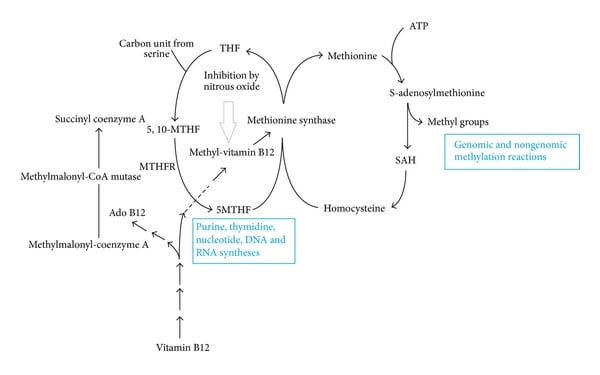Macrocytosis refers to a condition in which RBCs are larger than normal with an MCV>100 fl. Macrocytes can be seen on peripheral blood smear. It may be physiological in newborns, infants and pregnant women. When macrocytosis and anemia co-exist in the same person then the condition is called macrocytic anemia. It may be megaloblastic or non-megaloblastic.
Megaloblastic anemia is seen in Vit B12 or folate deficiency, pernicious anemia and transcobalamin II deficiency. It causes defects in DNA synthesis, cellular proliferation and maturation without much effect on RNA and cytoplasm synthesis. Vit B12 and folate deficiency are seen in dietary deficiency. B12 deficiency is more common in vegetarians, following gastrectomy, blind loop syndrome and pernicious anemia. Rarely, Diphyllobothrium latum infestations can cause B12 deficiency. When vitamin B12 is deficient, folic acid cannot be converted to its active form. It takes a few years to manifest Vit B12 deficiency while it takes only a few months to manifest folate deficiency.
Megaloblastic anemia due to vitamin B12 deficiency presents with fatigue, headache, palpitations, and dyspnea, and neurological symptoms such as dysesthesia and hypoesthesia, glossitis, gray hair; subacute combined degeneration with ataxia, decreased proprioception and vibration sensations is seen in severe cases. Neurologic symptoms are typically absent in folate deficiency anemia.
In megaloblastic anemia, large, oval RBC precursors called megaloblasts with an immature, “lacy” nucleus can be seen in the bone marrow. Bone marrow is hypercellular. Peripheral smear shows hypersegmented neutrophils (>5 lobes), macro-ovalocytes (large RBCs), poikilocytosis and anisocytosis. Macrocytosis is the earliest abnormality seen in complete blood counts of patients with folate or vitamin B12 deficiency. On peripheral smear, macrocytes will be larger than the nucleus of a small lymphocyte. Reticulocyte count will be low (<2%). MCV, MCH and RDW are increased while MCHC is normal or decreased. Serum LDH and unconjugated bilirubin may rise.
Serum homocysteine will be elevated in folate and Vit B12 deficiencies but methylmalonic acid will be elevated in Vit B12 deficiency only.

Pathways of intracellular vitamin B12 metabolism. MTHFR: methylenetetrahydrofolate reductase; 5,10-MTHF: 5,10-methylenetetrahydrofolate; 5-MTHF: 5-methylenetetrahydrofolate; THF: tetrahydrofolate; SAH: S-adenosyl homocysteine.
HoloTC II (holotranscobalamin II) is an emerging marker that may be useful in establishing a diagnosis of early vitamin B12 deficiency. RBC and serum folate levels will be low in folate deficiency. RBC folate levels are more specific to test for folate deficiency. Urinary levels of FIGLU or formiminoglutamic acid increase after histidine administration in folate deficiency. If both Vit B12 and folate levels are normal, other causes of megaloblastic anemia should be looked for.
Pernicious anemia (atrophic gastritis): It is an autoimmune gastritis characterized by the presence of anti-parietal cell and anti-intrinsic factor antibodies. Antibodies to H+/K+ATPase are seen. It mainly affects the gastric body and fundus. It manifests with hypochlorhydria (decreased gastric acid) production and Vit B12 deficiency anemia. Hypochlorhydria induces a feedback hypergastrinemia. It may be associated with other autoimmune diseases such as type 1 diabetes, autoimmune thyroiditis, and Addison’s disease. Patients with pernicious anemia are at high risk of developing gastric adenocarcinoma and carcinoid tumors. Treatment is with lifelong parenteral Vit B12 administration.
Sign up for free to take 4 quiz questions on this topic